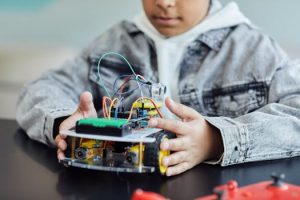Neurotechnology in Educational Support
In recent years, there has been a significant increase in the use of technology in the educational sector. From online learning platforms to augmented reality tools, technology has brought about major changes in the way students learn and educators teach. However, one aspect that is often overlooked is the impact of neurotechnology on educational support. This emerging field combines neuroscience and technology to better understand how the brain learns and processes information. In this article, we will explore the role of neurotechnology in educational support and how it is changing the way we approach teaching and learning.
The Rise of Neurotechnology in Education
Neurotechnology, also known as neurotech, is a rapidly growing field that focuses on the development and application of technologies that enhance and measure brain function. It encompasses various techniques such as brain-computer interfaces, electroencephalography (EEG), and transcranial magnetic stimulation (TMS). While these technologies have been primarily used in medical and scientific research, they are now finding their way into the education sector.
The use of neurotechnology in education has been driven by the increasing understanding of how the brain works and learns. Researchers have found that different parts of the brain are responsible for different functions, and certain brainwaves and neural patterns are associated with specific cognitive processes. By leveraging this knowledge, neurotech experts have been able to develop tools that target and stimulate specific areas of the brain, leading to improved learning outcomes.
How Neurotechnology is Changing Educational Support
1. Personalized Learning
One of the key benefits of incorporating neurotechnology in education is its ability to personalize learning. Traditional teaching methods often follow a one-size-fits-all approach, where all students are taught the same way. However, this approach ignores the fact that every student has a unique brain with different strengths and weaknesses. With neurotech tools, educators can assess the cognitive abilities of individual students and tailor their teaching accordingly. This not only helps students learn at their own pace but also enables them to reach their full potential.
2. Improving Attention and Focus
Attention and focus are critical for effective learning, and neurotechnology can help enhance these skills. For instance, brain-training games that utilize neurofeedback techniques can improve a student’s ability to concentrate and ignore distractions. Similarly, TMS devices can stimulate and strengthen specific areas of the brain responsible for attention and focus. This can be particularly helpful for students with attention deficits or learning disabilities.
3. Enhancing Memory and Recall
Neurotechnology can also play a significant role in improving memory and recall in students. By monitoring and analyzing brainwaves, neurotech tools can identify students’ difficulty in retaining information and provide targeted interventions to strengthen their memory. Moreover, neurotech can help students better encode and recall information through techniques such as transcranial direct current stimulation (tDCS) and auditory stimulation.
The Future of Neurotechnology in Education
As the field of neurotechnology continues to evolve, its potential for enhancing educational support is immense. With advancements in brain-computer interfaces, virtual and augmented reality, and artificial intelligence, the possibilities are endless. For example, in the near future, we might see educational games or simulations that adapt to a student’s brain activity in real-time, providing a truly personalized learning experience.
However, it is essential to note that neurotechnology is not a substitute for traditional teaching methods but rather a complementary tool. The success of neurotechnology in education depends on its integration with other classroom practices and the guidance of trained educators.
Conclusion
The use of neurotechnology in educational support has the potential to revolutionize the way we learn and teach. By combining scientific knowledge with advanced technology, neurotech tools can improve students’ learning abilities and lead to better academic outcomes. As we continue to understand more about how the brain works, we can expect to see even more innovative and effective neurotech solutions being integrated into the classroom.







